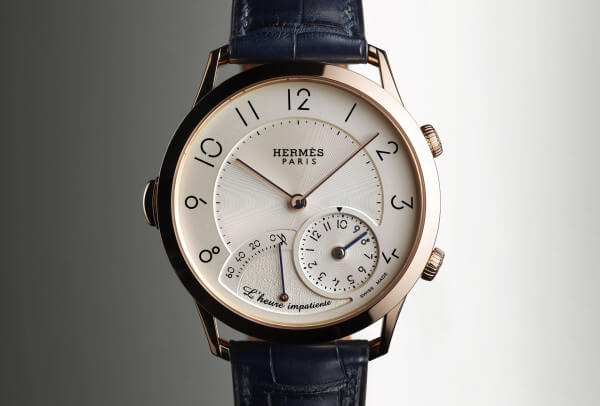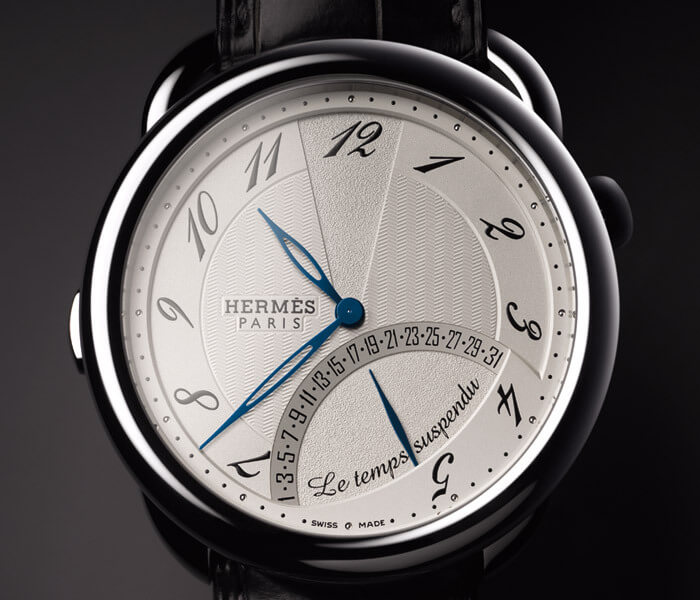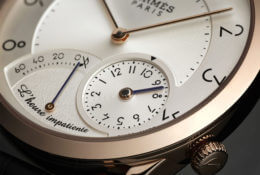It’s a habit of which I never grow tired: flipping the case of my small Jaeger-LeCoultre Reverso. A function intended to protect the dial from an eventual bang or knock. The protection I seek is of a different kind: one that will release me from the grip of time. A simple rotation and the hands are hidden from view. The ticking away of minutes and hours is erased, to be replaced by a more interior, subjective, altogether more amicable time. It’s a courtesy I extend to myself and others. At last, I’m taking my time.
I like watches that give Chronos a friendlier face. Hermès, a few years ago, brought out an Arceau watch complete with a metaphysical complication that defies the laws of physics: suspended time. A pusher freezes hour and minute hands on each side of noon. A position never normally seen on a dial; an absurdity that makes a mockery of perpetual motion. A vain complication, of course, but one that is no less delicious.

A mathematical absolute
Hermès came to the recent Baselworld fair with another singular innovation: L’heure impatiente. A disc on the dial of this model from the Slim collection serves to set the time of an eagerly-awaited event. Sixty minutes before the appointed hour, a small hand springs into action on an “hourglass” counter. Tick, tick, tick, the pressure mounts, excitement too. In complete contrast with the previous complication, which suspends time, this mechanism takes time by surprise. Generally rigid as an old demiurge on Mount Olympus, time draws itself out. A discreet chime sounds the end of the wait. A single, long note.
Which leave us to grapple with another complication, this time of a philosophical nature: the difference between time and duration. Le temps suspendu or L’heure impatiente may be considered fantasies, they mark the distinction between two times: one that is interior and subjective, and the other, exterior and objective. A distinction that is continually disputed, amended or refined. Possibly it doesn’t even exist, or is a different, as yet unknown phenomenon altogether. Albert Einstein said: “Put your hand on a hot stove for a minute and it seems like an hour. Sit with a pretty girl for an hour and it seems like a minute. That’s relativity.” Which changes nothing of the fact that Einstein’s time is scientific, discrete, irreversible, and external to us. It is a mathematical absolute.
We accept the idea that there is not just one time but several. The repetitive movement measured by a watch, the flux of consciousness, and others still. All of which come together as part of a universal design.
Science and consciousness
The philosopher Henri Bergson, who challenged Einstein’s concept of the nature of time, considered time to be indivisible and something we experience within ourselves. Yet Bergson said more or less the same thing as the inventor of general relativity: “If I want to mix a glass of sugar and water, I must wait until the sugar melts. This little fact is big with meaning. For here the time I have to wait is not mathematical time, which would apply equally well to the entire history of the material world. It coincides with my impatience, that is to say, with a certain portion of my own duration. It is no longer something thought, it is something lived.”
Intelligence versus intuition, physics versus consciousness, science versus philosophy: Einstein and Bergson were poles apart. Each considered the other’s time as a construct of the mind. Almost a century later, we are less dogmatic and accept the idea that there is not just one time but several. The repetitive movement measured by a watch, the flux of consciousness, and others still. All of which come together as part of a universal design. Even so, we are drawn back to Bergson’s notion of duration, composed of intuition, memory, freedom and vital force (Bergson’s élan vital). Yes, duration can be defined as the length of time between two points, a beginning and an end, but this is still an objective, real and measurable time. Bergson’s duration is an experience of time, a present that contracts or expands depending on how it is consciously experienced.
Like waiting for the one we love when the hands on our watch appear to have frozen to the dial. Or those other occasions when they seem to spin at incredible speed. All this is suggested in timepieces which, in reality, are anything but flights of fancy: time and duration are not the same thing. And so much the better!











